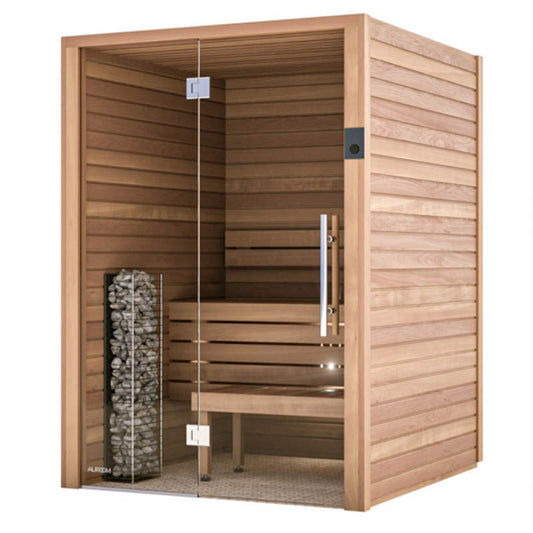Traditional Sauna - The Facts
Traditional Sauna - The Facts
Blog Article
Not known Incorrect Statements About Traditional Sauna
Table of ContentsSome Ideas on Traditional Sauna You Need To KnowThe smart Trick of Traditional Sauna That Nobody is Talking AboutTraditional Sauna Things To Know Before You BuyThe Basic Principles Of Traditional Sauna 3 Easy Facts About Traditional Sauna Shown
Power financial savings is something to consider for people that plan on using their sauna frequently. For a standard sauna, bathers usually require to wait for 30-40 minutes for the space to preheat prior to getting in. Infrared saunas, on the various other hand, generally reach their optimal temperature in around 15 minutes.That suggests that in an infrared sauna, bathers can begin enjoying their sauna instantly. One difference in between the 2 types of sauna that is often overlooked is the social experience.
Consider how many people will be utilizing the sauna prior to making your choice - Traditional Sauna. Including a sauna to your home can be one of one of the most exciting and satisfying choices you'll ever before make. Routine sauna use will certainly boost your circulation, maintain healthier skin, assistance kidney feature, reduce high blood pressure, enhance mind feature, and far more
The 20-Second Trick For Traditional Sauna

Infrared and typical dry saunas are both preferred alternatives for those seeking relaxation and restorative benefits. There are some crucial differences between the two types of saunas that ought to be thought about prior to making a selection. Standard completely dry saunas utilize heated rocks to generate vapor, while infrared saunas make use of infrared heating systems to straight heat the body.
Variables such as warmth tolerance, wanted level of detoxing, and general wellness ought to be considered when choosing which kind of sauna to utilize. Infrared saunas are a type of sauna that utilize infrared light to heat the body straight, instead than heating the air around the body like typical saunas.
The temperature level in an infrared sauna is usually reduced than in a traditional sauna, with temperature levels varying from 120F to 150F. Traditional Sauna. Infrared saunas supply a variety of benefits that make them an attractive alternative for those looking to improve their wellness and well-being. A few of the benefits of infrared saunas include: Infrared saunas make use of lower temperatures than traditional saunas, which can make them a lot more comfortable for those that discover heats tough to tolerate
The Ultimate Guide To Traditional Sauna
Infrared saunas have actually been shown to assist the body remove contaminants through sweating. Sweating can likewise assist to boost skin health by removing pollutants and dead skin cells.
The warmth generated by infrared saunas can aid to raise blood circulation and boost blood circulation. Infrared saunas have actually been revealed to aid lower stress and anxiety and advertise leisure.

Some Ideas on Traditional Sauna You Should Know

There are several advantages to using a typical completely dry sauna. Here are a couple of: Leisure: The high temperature and reduced humidity in typical dry saunas can help unwind the muscles and minimize tension levels. Detoxification: Sweating in a sauna can aid get rid of toxic substances from the body, which can enhance total health and wellness.
When it concerns saunas, there are 2 main kinds of heating approaches: standard and infrared. Typical saunas use warmed air to warm the body, while infrared saunas use infrared radiation to permeate the skin and warmth the body from within. Among the primary differences in between the two methods is the kind of heat they produce.
Standard saunas warm the air, which after that heats up the body through convection. Infrared saunas, on the various other hand, warmth the body straight through her comment is here radiation.
In regards to energy YOURURL.com efficiency, infrared saunas are usually much more efficient than typical saunas since they need much less power to run. They additionally warm up faster, so they can be used for much shorter sessions. When it involves the effects on the body, both sorts of saunas have actually been revealed to have benefits.
What Does Traditional Sauna Mean?
Infrared saunas have been revealed to have comparable benefits, as well as possibly aiding with cleansing, skin health, and immune feature. Overall, the option between a traditional or infrared sauna boils down to personal choice and individual demands. Conventional saunas might be better for those that choose greater temperatures and a much more intense sweat response, while infrared saunas may be much better for those that want an even more mild and efficient warm treatment.
Both kinds of saunas see this here provide unique benefits and downsides that ought to be taken into consideration before making a choice. The selection between an infrared sauna and a standard completely dry sauna mostly relies on personal preference and the preferred advantages - Traditional Sauna. Those who choose an even more comfy, lower temperature atmosphere might prefer an infrared sauna, while those who are seeking intense heat and a standard sauna experience might prefer a conventional dry sauna
Right here are some safety and security tips to bear in mind when utilizing infrared and typical completely dry saunas:: Saunas can cause extreme sweating, causing dehydration. It is necessary to drink a lot of water previously, throughout, and after sauna sessions to remain hydrated.: It is advised to restrict sauna sessions to 20-30 mins to stay clear of overheating and dehydration.
Report this page